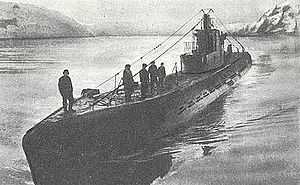Soviet submarine K-21

Soviet submarine K-21 was a K-class submarine of the Soviet Navy during World War II.[1][2]
History
The K-class of submarines were launched in 1938 and came in two variants, differentiated by the shape of the bow; the first group had flat bows, whilst the second group had humped bows. Of the submarines of the first group, K-21 was the only survivor after the war.[3][1]
K-21 was laid down in Leningrad Yard 196 on 10 December 1937 by Sudomekh, and was launched on 16 August 1939. The submarine served within the Northern Fleet.[4]
The German merchant ship Bessheim was sunk by a mine laid by K-21 on 11 November 1941. Between 9 November 1941 and 31 March 1942, K-21 unsuccessfully engaged three merchant ships and one German auxiliary patrol vessel. On 21 January 1942, Norwegian fishing boat F-223N Ingøy was sunk by gunfire from K-21.[4]
On 5 July 1942, K-21 made a solo unsuccessful attack on German battleship Tirpitz which was en route to intercept Convoy PQ 17. Tirpitz turned away, however the convoy scattered upon hearing words of Tirpitz's imminent arrival, and were picked off by U-boats and the Luftwaffe.[1]
K-21 sank four small Norwegian motor boats via gunfire on 12 February 1943 at Lopphavet. On 22 April 1943, the German merchant ship Duna was sunk by a mine laid by K-21 on 18 February 1943.[4]
After the war in October 1948, K-21 made the first Soviet submarine voyage off the coast of the United States.
In 1982, K-21 was made into a monument at Murmansk.
References
- ↑ 1.0 1.1 1.2 А. В. Платонов, (2004). Энциклопедия советских подводных лодок 1941-1945, Полигон. ISBN 5170249047.
- ↑ Lambert, (1986). Warship, Volume 10. Naval Institute Press. ISBN 0851774490.
- ↑ K-21 K-class Soviet cruiser submarine, Steelnavy.com
- ↑ 4.0 4.1 4.2 K-21
| ||||||||